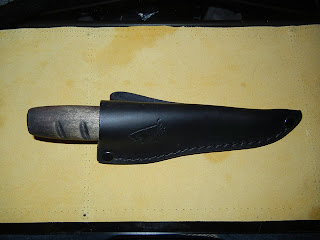I was very excited the day my order from
goknapping.com arrived. The box was packed perfectly and everything arrived in excellent condition, including a beautiful completed point scotch taped to my receipt. I could hardly wait to get home and start making chips.
Once I was settled in at home I started to set up. I put my drop cloth on the floor under the chair turned the fan on towards the open window, and donned my safety glasses and gloves. I chose a variety of rocks from my collection. I grabbed the gnarly knobby raw Texas that I had tried with the hammer, along with some
Novaculite and
Dacite from the kit. I was ready to knapp.
I wanted to at least test out all of the tools once. I had purchased a selection of both aboriginal and modern tools. I started with the modern ones.
In the above photo I am showing my now slightly abused copper bopper, copper tipped pressure flaker, and modern abrader.
I started with the nice brown Texas rock from ebay. I chose the copper bopper as my implement of destruction. I carefully examined the rock for a good platform (proper place to hit the rock,) made a few practice swings and then missed completely hitting my leg. Fortunately I had several layers of protective padding. After a few more swings I started making more regular and somewhat more accurate contact but I was getting very few controlled flakes. I also realized that I was swinging the bopper very much harder than I have seen in most videos. After getting a bit frustrated with this rock I switched over to some of the white Novaculite. Using the same force and angle I had just learned from half an hour on the raw "root beer" Texas; OG SMASH! I learned that Novaculite has entirely different properties from the raw Texas chert. The same force that would barely dent the raw stone rendered the heat treated rock into dust. Lesson learned in one small explosion of chunks and dust.
During this first marathon session I did also try out some of my abo tools.
In the photo above I am showing an antler billet, two antler pressure flakers and a sandstone abrader.
Over the next couple of hours I did manage to make a couple of small pre forms (worked pieces that are ready for further refinement) and what I will call my first point. I also was lucky and broke of a nice opportunistic flake that is in the shape of a claw with a nice finger grip. Despite the numerous layers of padding and other safety gear I still managed to make a large bruise on my leg, cut my hand in two places and get grit into the corner of my eye.
My First three 'points' and some attempts at pressure flaking
Two preforms and my first 'point'
This hammer stone did not hold up to the tough root beer Texas chert. Root beer is tough stuff.
Mounted the first one for posterity.
'The Claw' A rather nice opportunistic flake. The bottom edge is razor sharp.
The main lessons that I learned first hand today:
Different rocks have very different properties, and even different parts of the same rock can behave differently.
Knapping is a hand eye coordination muscle memory skill similar to playing an instrument or archery. Treat it like that kind of skill and when you get tired stop; you will learn bad habits when physically tired. The best guitar instruction I ever received was being told to simply play for 15 minuets EVERY day for a month. At the end of the month I could practice for two to three hours without getting tired, and then real learning could begin.
Knapping can be spectacularly frustrating. Watching hours of videos really does not prepare you for the fist time holding the rock. Most of the knappers that are making videos are very good. They make a hard skill look very easy and simple. There are very few videos of beginners making turtle backs and breaking preforms in half. What I've been able to gather from videos and books, is that it takes the average person about a year and a lot of material to get 'good.' I have heard the phrase, Time and tonnage, many times.
































